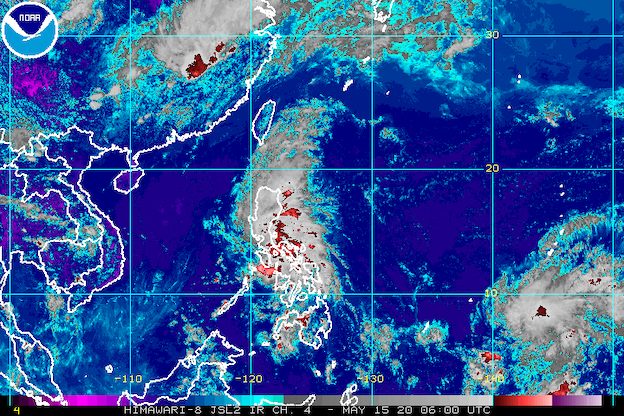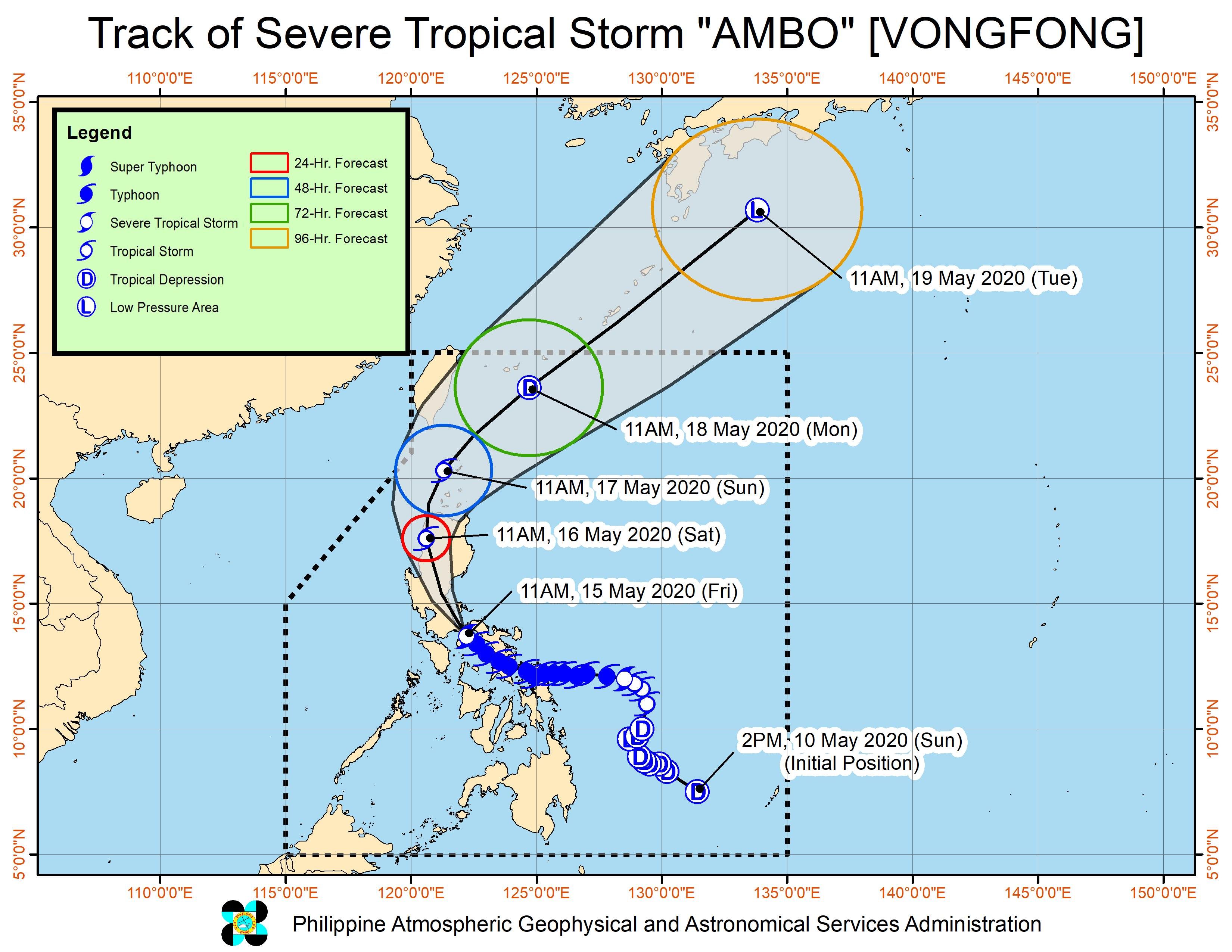SUMMARY
This is AI generated summarization, which may have errors. For context, always refer to the full article.

What’s the weather like in your area? Tweet us at @rapplerdotcom.
MANILA, Philippines – Ambo (Vongfong) weakened from a typhoon into a severe tropical storm as it continued to head for the northern part of Quezon and Laguna early Friday afternoon, May 15.
In a bulletin released past 2 pm on Friday, the Philippine Atmospheric, Geophysical, and Astronomical Services Administration (PAGASA) said Ambo is now in the vicinity of Agdangan, Quezon, still moving northwest at 20 kilometers per hour (km/h).
It now has maximum winds of 110 km/h from the previous 125 km/h and gustiness of up to 150 km/h from the previous 165 km/h. It is also expected to weaken further as it crosses land. (READ: FAST FACTS: Tropical cyclones, rainfall advisories)
Despite this, however, Ambo will continue to bring heavy rain and strong winds to areas in its path.
There are no more areas under Signal No. 3, but many areas in Luzon remain under Signal Nos. 1 and 2. (READ: Why is it now called tropical cyclone ‘wind’ – and not ‘warning’ – signals?)
Signal No. 2 (winds of 61 to 120 km/h, or strong to damaging gale-/storm-force winds during the passage of the severe tropical storm)
- Ilocos Norte
- Ilocos Sur
- Apayao
- Abra
- Kalinga
- La Union
- Ifugao
- Mountain Province
- Benguet
- Nueva Vizcaya
- Quirino
- Tarlac
- Nueva Ecija
- Aurora
- Pampanga
- Bulacan
- Rizal
- Metro Manila
- Laguna
- eastern part of Pangasinan (San Nicolas, Natividad, San Quintin, Umingan, Balungao, Sta Maria, Tayug, Asingan, San Manuel, Binalonan, Laoac, Urdaneta, Villasis, Rosales, Sto Tomas, Alcala, Bautista, Bayambang, Urbiztondo, Basista, Malasiqui, Sta Barbara, Manaoag, Mapandan, San Jacinto, San Fabian, Pozorrubio, Sison, Mangaldan, Dagupan, Calasiao, Binmaley, Lingayen, Bugallon, Aguilar, San Carlos, Mangatarem)
- western part of Isabela (Quezon, Mallig, Roxas, Quirino, San Manuel, Burgos, Gamu, Reina Mercedes, Aurora, Luna, Cabatuan, Naguilian, Benito Soliven, Cauayan, San Guillermo, Dinapigue, San Mateo, Alicia, Angadanan, Ramon, San Isidro, Echague, Jones, San Agustin, Santiago, Cordon)
- Cavite
- Quezon including Polillo Island
- Camarines Norte
- western part of Camarines Sur (Del Gallego, Ragay, Lupi, Sipocot)
- Marinduque
- Batangas
Signal No. 1 (winds of 30 to 60 km/h, or strong to near-gale-force winds during the passage of the severe tropical storm)
- Cagayan including Babuyan Islands
- Batanes
- rest of Pangasinan
- Zambales
- Bataan
- Oriental Mindoro
- Burias Island
- rest of Camarines Sur
- northern part of Albay (Tiwi, Malinao, Tabaco, Polangui, Libon, Oas, Ligao, Guinobatan, Pio Duran)
PAGASA maintained its rainfall outlook for Friday, and updated its forecast for Saturday, May 16.
Friday, May 15
Moderate to heavy rain, with at times intense rain
- Bicol
- Quezon
- Aurora
- Marinduque
- Laguna
- Rizal
- Metro Manila
- Bulacan
- Nueva Ecija
- Nueva Vizcaya
- Quirino
Saturday, May 16
Moderate to heavy rain, with at times intense rain
- Cordillera Administrative Region
- Ilocos Region
- Aurora
- Nueva Ecija
As a typhoon, Ambo had made landfall in the country 6 times – thrice on Thursday and thrice on Friday.
Thursday, May 14
- San Policarpo, Eastern Samar – 12:15 pm
- Dalupiri Island, Northern Samar – 10:15 pm
- Capul Island, Northern Samar – 10:30 pm
Friday, May 15
- Ticao Island, Masbate – 12 am
- Burias Island, Masbate – 3 am
- San Andres, Quezon – 7:45 am
Flash floods and landslides remain possible. The Philippine Institute of Volcanology and Seismology also warned on Wednesday, May 13, that the rainfall from Ambo might mix with volcanic deposits from Mayon Volcano’s 2018 eruption, which could result in lahar or volcanic mudflows in Albay.
Sea travel is still risky for all vessels in the seaboards of areas under tropical cyclone wind signals.
Ambo is expected to leave the Philippine Area of Responsibility on Monday, May 18. By then, it is likely to have weakened already into a tropical depression.

Ambo is the Philippines’ first tropical cyclone for 2020. The country gets an average of 20 tropical cyclones per year. (READ: LIST: PAGASA’s names for tropical cyclones in 2020)
In PAGASA’s climate outlook, it gave the following estimates for the number of tropical cyclones in the next 6 months:
- May – 1 or 2
- June – 1 or 2
- July – 2 to 4
- August – 2 or 3
- September – 2 or 3
- October – 2 or 3
Ambo’s arrival comes as the Philippines faces the coronavirus outbreak, with 11,876 cases as of Thursday. (READ: Social distancing ‘per family’ at Typhoon Ambo evacuation centers) – Rappler.com
Add a comment
How does this make you feel?
There are no comments yet. Add your comment to start the conversation.